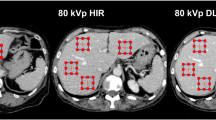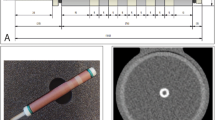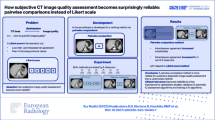Abstract
Background
Computed tomography (CT) is extremely important in characterizing blood vessel anatomy and vascular lesions in children. Recent advances in CT reconstruction technology hold promise for improved image quality and also reductions in radiation dose. This report evaluates potential improvements in image quality for the depiction of small pediatric vessels with model-based iterative reconstruction (Veo™), a technique developed to improve image quality and reduce noise.
Objective
To evaluate Veo™ as an improved method when compared to adaptive statistical iterative reconstruction (ASIR™) for the depiction of small vessels on pediatric CT.
Materials and methods
Seventeen patients (mean age: 3.4 years, range: 2 days to 10.0 years; 6 girls, 11 boys) underwent contrast-enhanced CT examinations of the chest and abdomen in this HIPAA compliant and institutional review board approved study. Raw data were reconstructed into separate image datasets using Veo™ and ASIR™ algorithms (GE Medical Systems, Milwaukee, WI). Four blinded radiologists subjectively evaluated image quality. The pulmonary, hepatic, splenic and renal arteries were evaluated for the length and number of branches depicted. Datasets were compared with parametric and non-parametric statistical tests.
Results
Readers stated a preference for Veo™ over ASIR™ images when subjectively evaluating image quality criteria for vessel definition, image noise and resolution of small anatomical structures. The mean image noise in the aorta and fat was significantly less for Veo™ vs. ASIR™ reconstructed images. Quantitative measurements of mean vessel lengths and number of branches vessels delineated were significantly different for Veo™ and ASIR™ images. Veo™ consistently showed more of the vessel anatomy: longer vessel length and more branching vessels.
Conclusion
When compared to the more established adaptive statistical iterative reconstruction algorithm, model-based iterative reconstruction appears to produce superior images for depiction of small pediatric vessels on computed tomography.





Similar content being viewed by others
References
Epelman M, Kreiger PA, Servaes S et al (2010) Current imaging of prenatally diagnosed congenital lung lesions. Semin Ultrasound CT MR 31:141–157
O’Connor OJ, Vandeleur M, McGarrigle AM et al (2010) Development of low-dose protocols for thin-section CT assessment of cystic fibrosis in pediatric patients. Radiology 257:820–829
Alibek S, Brand M, Suess C et al (2011) Dose reduction in pediatric computed tomography with automated exposure control. Acad Radiol 18:690–693
Lell MM, May M, Deak P et al (2011) High-pitch spiral computed tomography: effect on image quality and radiation dose in pediatric chest computed tomography. Invest Radiol 46:116–123
Winklehner A, Karlo C, Puippe G et al (2011) Raw data-based iterative reconstruction in body CTA: evaluation of radiation dose saving potential. Eur Radiol 21:2521–2526
Fuchs TA, Fiechter M, Gebhard C et al (2012) CT coronary angiography: impact of adapted statistical iterative reconstruction (ASIR™) on coronary stenosis and plaque composition analysis. Int J Cardiovasc Imaging 29:719–724
Baumueller S, Winklehner A, Karlo C et al (2012) Low-dose CT of the lung: potential value of iterative reconstructions. Eur Radiol 22:2597–2606
Katsura M, Sato J, Akahane M et al (2012) Comparison of pure and hybrid iterative reconstruction techniques with conventional filtered back projection: Image quality assessment in the cervicothoracic region. Eur J Radiol 82:356–360
Deak Z, Grimm JM, Treitl M et al (2013) Filtered back projection, adaptive statistical iterative reconstruction, and a model-based iterative reconstruction in abdominal CT: an experimental clinical study. Radiology 266:197–206
Pickhardt PJ, Lubner MG, Kim DH et al (2012) Abdominal CT with model-based iterative reconstruction (MBIR): initial results of a prospective trial comparing ultralow-dose with standard-dose imaging. AJR Am J Roentgenol 199:1266–1274
Beister M, Kolditz D, Kalender WA (2012) Iterative reconstruction methods in X-ray CT. Phys Med 28:94–108
Silva AC, Lawder HJ, Hara A et al (2010) Innovations in CT dose reduction strategy: application of the adaptive statistical iterative reconstruction algorithm. AJR Am J Roentgenol 194:191–199
Katsura M, Matsuda I, Akahane M et al (2012) Model-based iterative reconstruction technique for radiation dose reduction in chest CT: comparison with the adaptive statistical iterative reconstruction technique. Eur Radiol 22:1613–1623
Mieville FA, Berteloot L, Grandjean A et al (2013) Model-based iterative reconstruction in pediatric chest CT: assessment of image quality in a prospective study of children with cystic fibrosis. Pediatr Radiol 43:558–567
Smith EA, Dillman JR, Goodsitt MM et al (2013) Model-based iterative reconstruction: effect on patient radiation dose and image quality in pediatric body CT. Radiology. doi:10.1148/radiol.13130362 [Epub ahead of print]
Brooks RA, Di Chiro G (1976) Principles of computer assisted tomography (CAT) in radiographic and radioisotopic imaging. Phys Med Biol 21:689–732
Hounsfield GN (1973) Computerized transverse axial scanning (tomography). 1. Description of system. Br J Radiol 46:1016–1022
Suzuki S, Machida H, Tanaka I et al (2012) Measurement of vascular wall attenuation: comparison of CT angiography using model-based iterative reconstruction with standard filtered back-projection algorithm CT in vitro. Eur J Radiol 81:3348–3353
Machida H, Tanaka I, Fukui R et al (2013) Improved delineation of the anterior spinal artery with model-based iterative reconstruction in CT angiography: a clinical pilot study. AJR Am J Roentgenol 200:442–446
Singh S, Kalra MK, Do S et al (2012) Comparison of hybrid and pure iterative reconstruction techniques with conventional filtered back projection: dose reduction potential in the abdomen. J Comput Assist Tomogr 36:347–353
Scheffel H, Stolzmann P, Schlett CL et al (2012) Coronary artery plaques: cardiac CT with model-based and adaptive-statistical iterative reconstruction technique. Eur J Radiol 81:e363–e369
Yoon MA, Kim SH, Lee JM et al (2012) Adaptive statistical iterative reconstruction and Veo™ : assessment of image quality and diagnostic performance in CT colonography at various radiation doses. J Comput Assist Tomogr 36:596–601
Yu Z, Thibault JB, Bouman CA et al (2011) Fast model-based X-ray CT reconstruction using spatially nonhomogeneous ICD optimization. IEEE Trans Image Process 20:161–175
Willems PW, Taeshineetanakul P, Schenk B et al (2012) The use of 4D-CTA in the diagnostic work-up of brain arteriovenous malformations. Neuroradiology 54:123–131
Kritsaneepaiboon S, Lee EY, Zurakowski D et al (2009) MDCT pulmonary angiography evaluation of pulmonary embolism in children. AJR Am J Roentgenol 192:1246–1252
Neroladaki A, Botsikas D, Boudabbous S et al (2013) Computed tomography of the chest with model-based iterative reconstruction using a radiation exposure similar to chest X-ray examination: preliminary observations. Eur Radiol 23:360–366
Machida H, Takeuchi H, Tanaka I et al (2013) Improved delineation of arteries in the posterior fossa of the brain by model-based iterative reconstruction in volume-rendered 3D CT angiography. AJNR Am J Neuroradiol 34:971–975
Singh S, Kalra MK, Shenoy-Bhangle AS et al (2012) Radiation dose reduction with hybrid iterative reconstruction for pediatric CT. Radiology 263:537–546
Brady SL, Yee BS, Kaufman RA (2012) Characterization of adaptive statistical iterative reconstruction algorithm for dose reduction in CT: a pediatric oncology perspective. Med Phys 39:5520–5531
Rapalino O, Kamalian S, Kamalian S et al (2012) Cranial CT with adaptive statistical iterative reconstruction: improved image quality with concomitant radiation dose reduction. AJNR Am J Neuroradiol 33:609–615
Conflicts of interest
None
Author information
Authors and Affiliations
Corresponding author
Rights and permissions
About this article
Cite this article
Koc, G., Courtier, J.L., Phelps, A. et al. Computed tomography depiction of small pediatric vessels with model-based iterative reconstruction. Pediatr Radiol 44, 787–794 (2014). https://doi.org/10.1007/s00247-014-2899-y
Received:
Revised:
Accepted:
Published:
Issue Date:
DOI: https://doi.org/10.1007/s00247-014-2899-y




